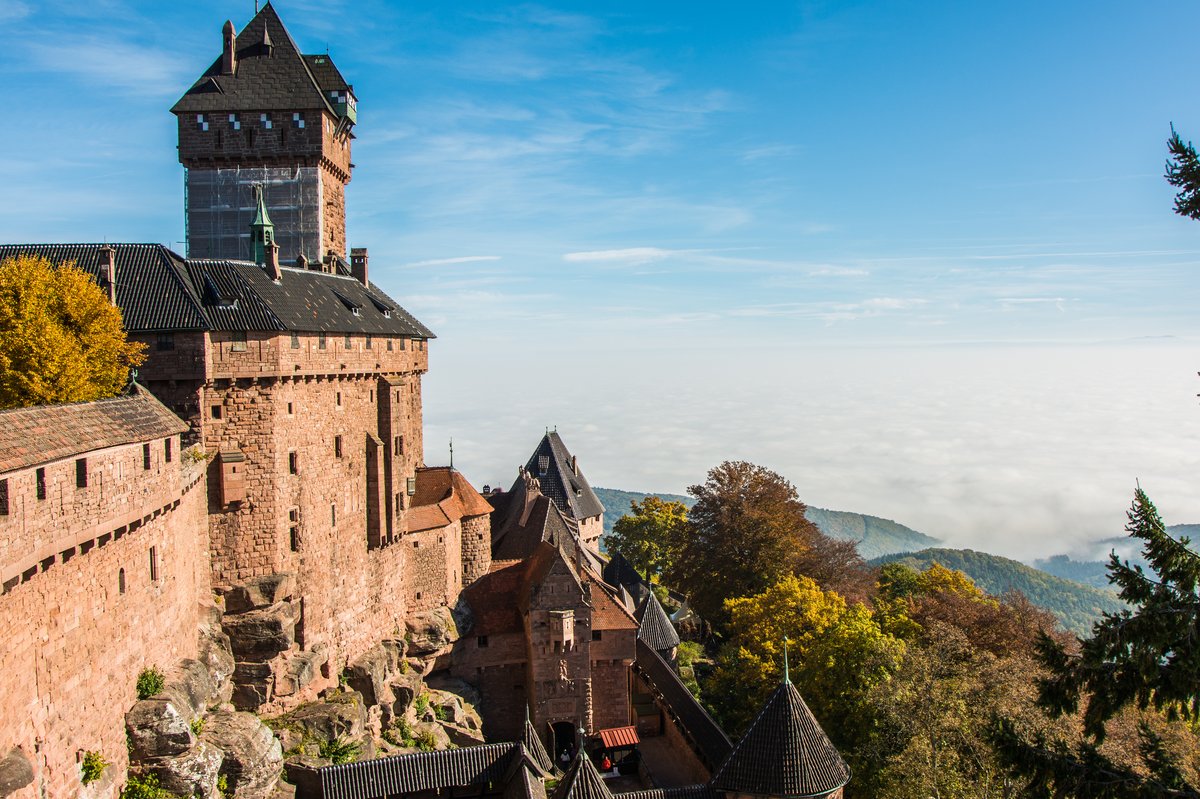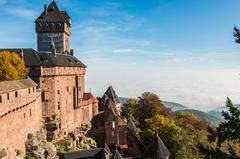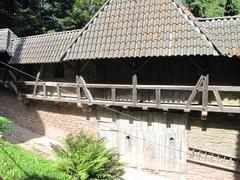
Visiting Château du Haut-Koenigsbourg, Sélestat, France: Tickets, Hours, and Travel Tips
Date: 14/06/2025
Introduction
Perched atop a 757-meter hill in the Vosges Mountains near Sélestat, Château du Haut-Koenigsbourg is one of Alsace’s most iconic castles and a testament to the region’s complex history. With origins tracing back over a millennium, this fortress has witnessed the ebb and flow of European power, warfare, and cultural exchange between France and Germany. Today, it stands as a meticulously restored monument, blending medieval architecture with early 20th-century romanticism, and welcomes over 500,000 visitors each year for immersive tours, stunning vistas, and cultural events (Wikipedia; europescastles.com).
This guide provides a comprehensive overview for visitors—covering history, ticketing and hours, how to get there, accessibility, nearby attractions, and practical tips—ensuring you make the most of your visit to this premier Alsace historical site.
Historical Overview
Strategic Origins and Medieval Transformations
The site’s strategic significance is documented as early as 774 CE, with its first castle constructed by the Hohenstaufen dynasty in the 12th century. Built to control vital trade routes across the Alsace plain, the fortress quickly became a symbol of regional authority, its elevation offering sweeping views of Alsace, the Black Forest, and, on clear days, the Alps (Wikipedia; castrumtocastle.com).
The castle changed hands frequently—passing from the Hohenstaufen to the Dukes of Lorraine, then to the Lords of Hohenstein, Rathsamhausen, and later the Counts of Thierstein. It endured sieges, destruction by regional coalitions, and was rebuilt to withstand evolving warfare, particularly the advent of artillery (castrumtocastle.com).
Decline, Restoration, and Symbolism
Devastated during the Thirty Years’ War in 1633 by Swedish forces, the castle lay in ruins for nearly two centuries. Rediscovered by the Romantic movement in the 19th century, it gained “monument historique” status in 1862. After Alsace was annexed by Germany in 1871, Kaiser Wilhelm II undertook a grand restoration, led by Bodo Ebhardt, to recapture the castle’s late medieval grandeur while asserting imperial German identity. Completed in 1908, the restoration combined archaeological research with romanticized medieval aesthetics (haut-koenigsbourg.fr).
Returned to France after World War I, the castle now stands as a symbol of Franco-German reconciliation and shared European heritage (europescastles.com).
Visiting Information
Location and Access
Château du Haut-Koenigsbourg is located near Orschwiller, about 10 km west of Sélestat, 34 miles south of Strasbourg, and 16 miles north of Colmar (Wyld Family Travel; TravelAwaits).
Getting There:
- By Car: 25-minute drive from Sélestat; parking is limited—arrive early, especially in peak season (Family Can Travel).
- By Shuttle Bus: A regular shuttle connects Sélestat train station to the castle, stopping at other attractions like Monkey Mountain and Eagle Park (Funbooker).
- By Train/Bus: Trains from Strasbourg or Colmar to Sélestat, then transfer to the shuttle.
- Organized Tours: Available from major Alsatian cities and often include tickets and a guide.
Opening Hours
- April to September: 9:30 AM – 6:00 PM
- October to March: 10:00 AM – 5:00 PM
- Closed: January 1, December 25, December 26
Last admission is typically 45 minutes before closing. Always check the official website for updates.
Tickets and Prices (2025)
- Adults: €9–10
- Reduced (students, seniors): €6–7
- Children under 18: Free
- Audio guide rental: ~€4
- Family/group rates: Available
- Free entry: First Sunday of each month (Nov–Mar), European Heritage Days in September (haut-koenigsbourg.fr)
Book tickets online in advance to avoid queues, especially in summer (Funbooker).
Tours and Visitor Experience
- Self-Guided Tours: Explore the castle’s courtyards, ramparts, and furnished chambers at your own pace. Audio guides provide rich historical context (Civitatis).
- Guided Tours: Offered daily in multiple languages; highly recommended for history and architecture enthusiasts (Wyld Family Travel).
- Special Events: Themed activities, reenactments, and workshops are held throughout the year. Check the events calendar on the official website.
Accessibility
- Mobility: Partial accessibility due to historic architecture. Some areas have ramps; many require stair climbing.
- Assistance: Guide dogs and assistance animals welcome with proof; other pets not allowed.
- Facilities: Restrooms, souvenir shop, picnic areas, and the Tavern du Haut-Koenigsbourg for Alsatian cuisine (haut-koenigsbourg.fr).
Highlights and Nearby Attractions
Key Features
- Defensive Walls and Drawbridge: Enter via a drawbridge, ascend ramparts, and experience authentic medieval fortifications.
- Courtyards and Keep: Explore the central courtyard, armory, royal apartments, and unique medieval toilets.
- Exhibits: Authentic and reproduction furnishings, weapons, and tapestries.
- Panoramic Views: Breathtaking vistas of the Alsace plain, Vosges, Black Forest, and Alps.
Nearby Attractions
- Sélestat: Known for its Humanist Library and medieval city center.
- Alsace Wine Route: Picturesque villages and vineyards.
- Orschwiller Village: Traditional Alsatian houses and local eateries.
- Monkey Mountain, Eagle Park, Cigoland: Family-friendly nature and wildlife attractions (Wyld Family Travel).
Practical Visitor Tips
- Arrive Early: Especially recommended in summer and on weekends for parking and a quieter experience.
- Wear Sturdy Shoes: Uneven surfaces and many stairs.
- Weather: Exposed hilltop—bring layers, sun protection, or a jacket.
- Photography: Allowed throughout most areas; flash use may be restricted.
- Duration: Allow 2–3 hours for a thorough visit.
- Dining: The tavern offers regional dishes; picnicking is permitted in designated areas.
Frequently Asked Questions (FAQ)
What are the château’s opening hours?
9:30 AM – 6:00 PM (April–September); 10:00 AM – 5:00 PM (October–March). Always verify before your visit.
How do I buy tickets?
Online via the official website or at the entrance. Online booking recommended during peak periods.
Are guided tours available?
Yes, in several languages daily; check the website for times and availability.
Is the castle accessible for people with reduced mobility?
Partial accessibility; many areas require stairs. Contact the château in advance for accommodations.
Can I bring my pet?
Only service animals with proof are allowed inside.
Are there any COVID-19 restrictions?
Check the official website for the latest guidelines.
Essential Summary and Travel Recommendations
Château du Haut-Koenigsbourg is a must-see destination for anyone exploring Alsace—offering a vivid journey through nine centuries of European history, architectural mastery, and cultural fusion. Its dramatic restoration, strategic location, and well-developed visitor facilities make it an enriching experience for families, history buffs, and casual tourists alike (castrumtocastle.com; europescastles.com).
Maximize your visit by:
- Booking tickets online in advance
- Arriving early to beat the crowds
- Taking a guided or audio tour for deeper insight
- Exploring nearby towns and the Alsace Wine Route
For the latest information, visit the château’s official website, download the Audiala app for audio guides and cultural itineraries, and follow on social media for updates and special events.
Sources
- Wikipedia
- Castrum to Castle
- Château du Haut-Koenigsbourg Official Website
- Europe’s Castles
- Wyld Family Travel
- Funbooker
- Snippets of Paris
- TravelAwaits

